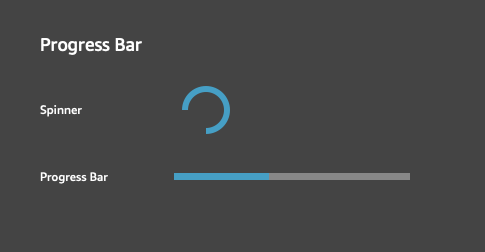IN THIS ARTICLE
O3DE UI Progress Indicators
Use progress and status indicators to communicate to users that the O3DE application is working on a process, and what the result of that process is when it’s finished. Indicators should be employed when there’s a chance the user could be left wondering whether or not a process is working or hung.

Usage guidelines
Follow these guidelines as you design your UI with progress indicators:
Display progress when a latency of 3 milliseconds or more is expected.
Consider context and flow when determining where and when to show progress.
Progress indicators are animated to reinforce that an activity is occurring.
Note:See additional usage guidelines in the following sections, which apply to specific types of progress indicators.
Avoid these design choices when using progress indicators:
- Don’t use more than one progress indicator at a time.
Basic progress bar

Display determinate progress as a linear progress bar, to show a process or a task that has a definite start and end. In this scenario, the system is aware of how many steps are taken, and a likelihood of time for completion.
In the case where a system is malfunctioning, or doesn’t have either of these data points, consider using a spinner.
Additional usage guidelines for progress bars include the following:
If possible, use text to clearly display to the user that the system is working. For particularly long processes, consider using a combination of text to indicate where they are in the process, as shown in the previous image.
When available, display a numeric count under the progress bar, too.
For progress bars in a dialog, provide a single button to cancel the process.
The following example demonstrates the initialization of a simple progress bar. Refer to the Qt documentation on QProgressBar to learn additional features.
Example
#include <QProgressBar>
// Create the progress bar.
QProgressBar* progressBar = new QProgressBar(parent);
// Set the numeric range of the bar.
progressBar->setRange(0, 36);
// Set the current progress value.
progressBar->setValue(12);
// Hide the progress text, as specified by the UX spec. It defaults to on, so it should be turned off.
progressBar->setTextVisible(false);
// Note that it can also be set from the .ui file, or from Qt Designer or Creator.
Basic progress spinner

Use spinners when it’s unclear when the process will finish.
Additional usage guidelines for spinners include the following:
- Display spinners in the context of windows, panels, lists, or inline with other elements.
Example
#include <AzQtComponents/Components/StyledBusyLabel.h>
// Create the spinner.
AzQtComponents::StyledBusyLabel* spinner = new AzQtComponents::StyledBusyLabel(parent);
// Set the spinner icon size.
spinner->SetBusyIconSize(18);
// Start the spinner.
spinner->SetIsBusy(true);
C++ API reference
For details on the progress indicator API’s, see the following topics in the O3DE UI Extensions C++ API Reference:
Relevant Qt documentation includes the following topics:
